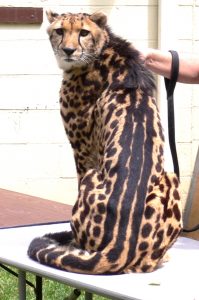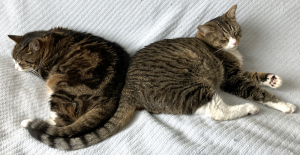Plus Sitcom Geeks look back on the Big Comedy Conference, how to sell a book on Substack, showrunner John Rodgers on the WGA strike, king cheetahs, and more!
Hi there,
There’s much to share in this week’s newsletter, so let’s just get on with it!
Opportunity: WFTV Kay Mellor Screenwriters’ Lab 2023
Women in Film & TV (UK) is launching the Kay Mellor Screenwriters’ Lab, a fully funded mentoring and development program for 13 currently un-agented and un-produced female screenwriters. Successful applicants will get to spend five days working on their original scripts, with the aim that by the end of the program, they’ll be ready to find an agent or pitch their project to an independent production company.
The programme will consist of craft writing masterclasses, tutor-led workshops and independent writing time. In addition, across the week there will be evening sessions with special guests from the industry, including Happy Valley creator and writer, Sally Wainwright OBE.
The residential workshop will run from Monday 2 October to Saturday 7 October 2023. Applications close at 17:00 BST on Wednesday 24 May.
Opportunity: Free comedy mentoring
 Comedian, writer and presenter Sadia Azmat (right) is offering to mentor six people “who are looking for support in writing and/or stand-up comedy”. Each mentee will be offered a monthly hour-long session for up to six months.
Comedian, writer and presenter Sadia Azmat (right) is offering to mentor six people “who are looking for support in writing and/or stand-up comedy”. Each mentee will be offered a monthly hour-long session for up to six months.
To apply, “simply send a short statement about who you are, what your comedy goals are and why you think you’d benefit from these free sessions with Sadia to pro@comedy.co.uk by 1st June.”
Competition: Virago Press launches Furies short story comp
Virago Press, the feminist book publisher, is launching the Furies short story competition as part of their 50th birthday celebrations. Submissions must be “an original, feminist short story inspired by a synonym for ‘virago’,” and the competition is open to writers from underrepresented backgrounds.
The competition has some pretty specific terms and conditions, so read carefully before you start writing. In particular:
“The story must not be inspired by a synonym for ‘virago’ or any other word which has already been used as inspiration for a story by a contributor to the existing edition of FURIES. These are: siren, virago, churail, termagant, wench, hussy, vituperator, harridan, warrior, she-devil, muckraker, spitfire, fury, tygress and dragon.”
Which, according to my computer’s built-in dictionary, leaves you with shrew, vixen, fishwife, witch, hellcat, tartar, martinet, hag, gorgon, ogress, harpy, nag, trout, battleaxe, old bag, old bat, cow, bitch, targe, scold and Xanthippe.
The deadline is 11.59pm BST on Saturday, 1 July 2023.
Stop, look, listen: Sitcom Geeks, E218 – Conference Calling
If you didn’t get along to the Big Comedy Conference last month, then you can get a taste of what you missed with the Sitcom Geeks podcast. In this latest episode, James Cary and Dave Cohen talk about the first two sessions from the conference which featured commissioners and producers talking about the commissioning process.
Sadly, the Sitcom Geeks podcast will be ending with episode 222 on 6 July, due to both James and Dave getting too busy to continue. I’ve only just discovered the podcast, so I guess I’ll just have to work backwards through the archives.
Read this: How to sell a book on Substack
Substack has written a guide on how to sell a book on Substack, including how to promote via preorders and book launches, and using tactics such as using custom buttons, telling your paid subscribers first, providing behind-the-scenes content, and offering discounts. They also look at how to do ongoing promotion by adding your books to your Substack and using custom banners, and growing your audience at the same time as your sales.
The section that will eventually be of most interest to me is the section on how to pitch one’s newsletter to agents and publishers. Several Substack writers have landed book deals because their newsletter had developed a huge audience with a high open rate. I’m doing well on open rate, but just need another, oh, 59,700 subscribers.
Stop, look, listen: The Writers Panel – Strike Talk with John Rogers
Screenwriter Ben Blacker talks to WGA Board Member and showrunner John Rogers about why writers are on strike plus “what’s at stake, how negotiations broke down, and how long this might last”.
John also makes the really good point that writers aren’t asking for anything outrageous. They’re not being greedy. Fifty per cent of writers are working for the union minimum, and that includes showrunners who’ve been in the business for 20 years. Writers’ pay has dropped real terms, so what they’re asking is just for the last decade’s worth of decline in pay to be reversed.
Meanwhile, as John says, “The companies are averaging between $28 and $30 billion in profit – not revenue, profit – a year. And that’s during COVID when they were afraid they were going to bottom out.” The studios and streams can absolutely afford to pay authors a living wage.
Anyway, give the episode a listen, it’s a great insight into what’s going on and why.
Tweet of the week
From writer, director and producer Justine Bateman:
AI is being used to replace human expression for the sake of greed. The #WGA fight can become a template for other industries. I’ve heard of paralegals being replaced with ChatGPT at a legit law firm, & medical grad student being replaced by ChatGPT for medical research. 1/
Suw’s News: What is “easy”?, Substack Notes, and Bluesky
- When the easiest route becomes the hardest. Sometimes, writing my Why Aren’t I Writing? newsletter turns out to be a much bigger challenge than I have time for, and last week was a prime example. So I wrote about how sometimes, looking for the ‘easiest’ option turns out to be an exercises in making life harder. (Though to be fair to me, it turned out that I was incubating a cold, so no wonder my brain was feeling foggy!)
- Is the Notes honeymoon over? I wrote an essay for paid subscribers – with graphs! – about my experience of the Substack Notes subscriber bump, and of trying to work out which social media platform is the best for getting word out to potential subscribers.
- I’m on Bluesky! I know that Bluesky is still invite-only as they try to control their growth, and it’s still an incredibly basic experience, but if you’re there, say hello! (Please note: I don’t have any invite codes.)
Obligatory cat picture
Back in August 2018, just a few months after we first moved to Shaker Heights, my husband and I visited Cleveland Zoo for the first time. It was a stonking hot day, and this sleepy cheetah could only be captured at full zoom. Having raised its head to squint at us, it promptly went back to sleep. Can’t say I blamed it.

Whilst I was just looking up a few cheetah facts, though, I discovered the existence of the rare king cheetah, which has a mutation that results in darker spots and three distinctive stripes down the back. I’d suggest that these were go-faster stripes, but it’s not like the cheetah needs any help with speed.
Anyway, it turns out that the king cheetah has a mutation in the same gene that’s responsible for the variation in coat pattern in domestic tabby cats, specifically the mackerel tabby (eg Copurrnicus) and the blotchy or classic tabby (eg Grabbity). In the case of cheetahs, the mackerel version is the normal spotty cheetah, and the blotchy version is the rare king cheetah.
You can see the difference between blotchy Grabbity (left) and mackerel Copurrnicus (right) quite clearly. It’s hard to tell from this photo, but Grabbity does have three poorly defined stripes along parts of her spine. Thanks, transmembrane aminopeptidase mutation!
Right, that’s more cat photos than I think any of us bargained for this week!
Ciao bella,
Suw
{ Comments on this entry are closed }






